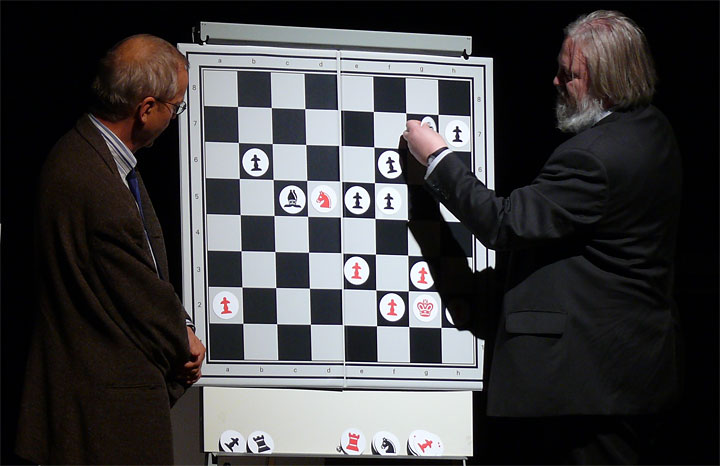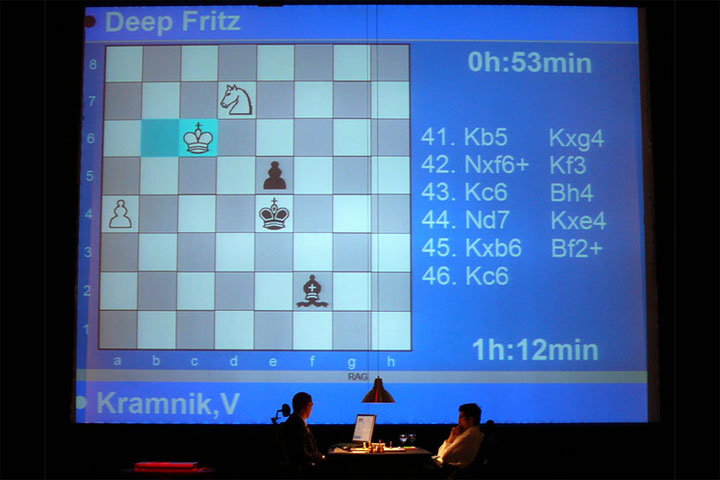
Mathias Feist, who operated Deep Fritz against Kramnik, and GM Yasser Seirawan, analyse the critical endgame after the match. On the right: Deep Fritz opening book author Alexander Kure.

GMs Helmut Pfleger and Artur Jussupow analysing the endgame of Kramnik-Deep Fritz (1)
Could Kramnik have won game one?
This is where we sought your analytical help. In my opinion, in game one Kramnik reached a favorable endgame, and I believed that a winning proof could be found. It was, with the help of our readers. Before this, I was, let us say, 80% sure he was winning. Now I am 99% sure. Of the riddles presented so far only Petrosian vs Fischer resisted modern engines for real, and needed critical human input. There I received many wrong proofs a few weeks ago.
Older sources analysing Kramnik-Deep Fritz contain many mistakes, including one by myself in ChessBase Magazine which was found by Garry Kasparov and Mathias Feist. This time I did not find mistakes in the readers' analysis. This shows us that engines, and the latest analytical functions provided by ChessBase, have improved a lot
 As usual, Zoran Petronijevic gave the most convincing winning proof. He established several points:
As usual, Zoran Petronijevic gave the most convincing winning proof. He established several points:
- After 28...Kg7 Black is lost. This move is a glaring error – after the better 28...Ke8, the position is even. But this wasn't the question.
- The move 29.Nd5 is winning, although 29.Kf3 was also possible. It leads to similar lines.
- Kramnik's decisive mistake was 30.a4? after which he cannot win. Instead, 30.e3 was winning, although that isn't the only one. The moves 30.Kf1 or 30.Kf3 also win – they lead to similar position as 30.e3.
- 31.e3 does not win – Black has the astonishing 31...f6.
- The most interesting line for me was 33.e3, which leads to a draw after 33...e4. I also analyzed 33...h5 which seems to be a clear mistake. However, even here I didn't find a win for White, which to me is almost unbelievable.
Charles Sullivan has checked Zoran Petronijevic's proof and found two minor, repairable errors, which I have added directly to Zoran's fantastic piece of work. Alberto Oggero, Michael Taktikos and Kurt Utzinger bascially came to the same conclusions independently, so it can safely be concluded that Kramnik indeed was winning.
Here is the analysis in full. Careful, it is very extensive.

[Event "Bonn Man-Machine"] [Site "Bonn"] [Date "2006.11.25"] [Round "1"] [White "Kramnik, Vladimir"] [Black "Deep Fritz 10"] [Result "1/2-1/2"] [ECO "E03"] [WhiteElo "2750"] [Annotator "Petronijevic,Zoran"] [PlyCount "94"] [EventDate "2006.11.25"] [EventType "match"] [EventRounds "6"] [EventCountry "GER"] [SourceVersionDate "2016.11.12"] 1. d4 Nf6 2. c4 e6 3. g3 d5 4. Bg2 dxc4 5. Qa4+ Nbd7 6. Qxc4 a6 7. Qd3 c5 8. dxc5 Bxc5 9. Nf3 O-O 10. O-O Qe7 11. Nc3 b6 12. Ne4 Nxe4 13. Qxe4 Nf6 14. Qh4 Bb7 15. Bg5 Rfd8 16. Bxf6 Qxf6 17. Qxf6 gxf6 18. Rfd1 Kf8 19. Ne1 Bxg2 20. Kxg2 f5 21. Rxd8+ Rxd8 22. Nd3 Bd4 23. Rc1 e5 24. Rc2 Rd5 25. Nb4 Rb5 26. Nxa6 Rxb2 27. Rxb2 Bxb2 28. Nb4 {I have started from here.} Kg7 $4 {[#]} ({This move loses. After} 28... Ke8 {The position is even. Seirawan didnt notice this moment in his comments.}) 29. Nd5 ({The game move wins. We should notice that also} 29. Kf3 {wins.} Bd4 (29... e4+ 30. Kf4 Kg6 31. Nd5 Ba3 32. Ke5 b5 33. Nc7 b4 34. Nd5 Bb2+ 35. Kf4 Bd4 36. e3 Bc5 37. Ke5 Bf8 38. Kd4 $18) (29... b5 30. Nd5 Bd4 31. e3 $18 {I analyze this position bellow.}) (29... Ba3 30. Nd5 Bc5 31. e3 $18 {See analyzes in 29.Nd5 Bd4 30.e3 Bc5 31,Kf3}) 30. e3 Bc5 31. Nd5 $18 {I analyze this position in 29.Nd5 Bd4 30.e3! line.}) 29... Bd4 (29... b5 { In his comments for CBM 116 Braun A. puts "?" to this move. However, in my opinion the position is lost anyway, so no need to evaluate this move as a mistake.} 30. Nc7 b4 31. Nd5 Ba3 (31... Bc3 32. a3 $18 {(Braun A.) Let's continue} bxa3 33. Nxc3 Kg6 34. Kf3 Kf6 35. h3 Kg5 36. h4+ Kg6 37. e4 h5 38. Ke3 Kf6 39. Kd3 Ke6 40. Kc2 fxe4 41. Nxe4 f5 42. Nc3 f4 (42... Kd6 43. Nb5+ $18 ) 43. gxf4 Kf5 44. fxe5 Kxe5 45. Ne2 Ke4 (45... Kf5 46. f3 $18) 46. Ng3+ Kf4 47. Nxh5+ $18 {and now win is too obvious.}) 32. Kf3 {(+/-Braun A.) In my opinion this position is winning for white. Lets see a proof:} Bb2 (32... Kg6 { loses after} 33. e4 fxe4+ 34. Kxe4 Kg5 35. f3 Kh5 36. Kxe5 Kg6 37. Kd4 Kf5 38. Kc4 Ke5 39. Nxb4 $18 {Black is deadly lost.}) 33. e4 (33. e3 {also wins although somewhat slower.} e4+ 34. Ke2 Kf8 35. Nxb4 Ke7 36. Nc6+ Kd6 37. Nd4 Ke5 38. a4 $18) 33... Kg6 (33... Bd4 34. exf5 Bc5 35. Ke4 $18) 34. Nxb4 Bc3 35. Nc6 Kf6 36. a4 Ke6 37. exf5+ Kd7 (37... Kxf5 38. a5 $18) 38. Na7 Be1 39. Nb5 Kc6 40. Ke4 f6 41. f3 $18 {[%cal Ye4d3,Rb5c3,Rc3e4]}) 30. a4 $2 {This move is throwing away all his advantage.} (30. e3 $1 {was wining move} Bc5 31. Kf3 { "The white king heads for b5." (Braun A.)} Kg6 (31... f6 32. Ke2 Kf7 (32... e4 33. Kd2 Kf7 34. Kc3 b5 35. Nc7 Bb6 36. Nxb5 Ba5+ 37. Kc4 Be1 38. a4 Bxf2 39. a5 Bxe3 40. Nd4 f4 41. gxf4 Bxf4 42. a6 Bb8 43. Nc6 $18) 33. Kd3 Ke6 34. Kc4 $18 { "Black is suddenly in zugzwang (and there is the additonal threat of a4-a5)." - Braun A. If we continue a bit} h6 35. a4 h5 36. a5 {we can see that Braun was right.}) (31... b5 32. Ke2 e4 33. Nc3 (33. Nc7 b4 34. Nd5 {Transposes to main line.}) 33... b4 34. Nd5 Kh6 (34... Kg6 35. Nf4+ Kg5 (35... Kf6 36. Kd2 h6 (36... b3 37. axb3 Bb4+ {Black is hoping to attack White's King side pawns.} 38. Kd1 Ke5 39. Ne2 Bc5 40. Nd4 Kf6 41. Nc6 Ke6 42. Kd2 Kd5 43. Nd4 Bd6 44. Nxf5 $18) 37. h3 Bd6 (37... Be7 {leads to the same positions as in main line.}) 38. Kc2 Kg5 39. Kb3 h5 40. Ng2 ({Charles Sullivan adds} 40. Kc4 $2 h4 $1 $11) 40... Bf8 41. Kc4 Bd6 42. Kb5 Bf8 43. Kc6 {King dominates!} Bg7 44. Kd6 Kg6 ( 44... Bf8+ 45. Kd7 Bc5 46. Nf4 Bf8 47. Ke8 $18) 45. Kc5 Bf8+ 46. Kc6 Bg7 (46... Be7 47. h4 Bf8 48. Nf4+ Kh6 49. Kb5 Kg7 50. Nd5 $18 {[%csl Rb4][%cal Rd5b4]}) 47. Kb5 Bf8 48. h4 f4 49. exf4 Bd6 50. Kc4 Kf6 51. Ne3 Ke6 52. Kd4 Bb8 53. Kxe4 $18) 36. h3 Bb6 (36... Kf6 37. Kd1 Ke5 (37... b3 38. axb3 Ke5 39. Ne2 Kf6 40. Nd4 Bb4 41. Nc6 Bc3 42. b4 Ke6 43. Nd4+ Kd5 44. b5 f4 45. gxf4 Kc5 46. Nf5 Bb4 47. Ng3 Kxb5 48. Ke2 Kc6 49. Nxe4 $18) (37... Bd6 38. Kc2 Kg5 39. Kb3 Bf8 40. Kc4 h5 41. Ng2 Be7 42. Kb5 Bf8 43. Kc6 Bg7 44. Kd6 Kg6 45. Kc5 Bf8+ 46. Kc6 Bg7 47. Kb5 Bc3 48. Kc4 Bd2 49. Kb3 Kf6 50. Kc2 Bc3 51. a3 Ke6 52. Kb3 Bd2 53. axb4 f4 54. gxf4 Kd5 55. f5 f6 56. Nf4+ Ke5 57. b5 Be1 58. b6 Ba5 59. b7 Bc7 60. Nxh5 Kxf5 61. Kc4 Ke6 62. Kc5 $18) 38. Kc2 Bb6 39. Kb3 Ba5 40. Ne2 Ke6 41. Nd4+ Kd5 42. Nxf5 Kc5 43. g4 Kd5 44. Ng3 Ke5 45. Kc4 b3 46. axb3 Be1 47. b4 Bxf2 48. Nf5 Ke6 49. b5 Be1 50. Kc5 Kd7 51. Kd5 Ba5 52. Nd6 Bb6 53. Nc4 Bd8 54. Ne5+ Ke8 55. Kxe4 $18) 37. Kd1 Ba5 38. Nd5 h5 39. h4+ Kg4 40. Ke2 f4 41. Nxf4 Bc7 42. Nd5 Bd6 43. Nf6+ Kf5 44. Nxh5 $18) 35. h3 Kg5 36. Nf4 b3 ({Charles Sullivan adds} 36... h5 37. Ng2 $1 $18) 37. axb3 Kf6 38. Kd1 Ke5 39. Ne2 Kf6 40. Nd4 Bb4 41. Nc6 Bf8 42. Ke2 Ke6 43. Kd2 Kd5 44. Nd4 Bb4+ 45. Ke2 Bf8 46. Nxf5 $18) ( 31... Kh6 32. a4 Kg5 33. Ke2 f4 34. gxf4+ exf4 35. Nxf4 Bb4 36. Kd3 Kg4 37. Nd5 Bc5 38. Kc4 h5 39. Kb5 h4 40. f4 $2 ({Charles Sullivan gives} 40. Nxb6 $18) 40... Kh3 41. Nxb6 Bd6 $2 ({Charles Sullivan adds} 41... Bxe3 $11) 42. a5 Bb8 43. a6 Kxh2 44. Kc6 Ba7 45. Kb7 h3 46. Kxa7 Kg3 47. Kb8 h2 48. a7 h1=Q 49. a8=Q $18) 32. a4 (32. Ke2 Kg5 33. h3 {(Braun A.) - also wins.}) 32... Kh6 (32... f4 33. gxf4 exf4 34. Kxf4 Kh5 (34... Bd6+ 35. Ke4 Bxh2 36. f4 Bg3 37. Nxb6 Be1 38. Nc4 $18 {[%cal Ya4a5]}) 35. Nf6+ Kg6 36. Ke5 Bb4 37. Nd7 Ba5 38. f4 Kh5 39. Nf6+ Kg6 40. Nd5 Kh5 41. Kf5 Bd2 42. e4 Kh6 43. Kf6 $18 {[%cal Rf6f7,Re4e8]}) 33. h3 e4+ 34. Ke2 Kg5 35. Kd2 h5 36. h4+ Kg4 37. Ke2 {[%csl Rf6][%cal Rd5f6, Rf6h5]} f4 38. Nxf4 Be7 39. Nd5 Bd8 40. Ke1 Kf5 (40... Kf3 41. Kf1 Kg4 42. Ke2 f6 43. Kd1 Kh3 44. Ke1 Kg4 45. Ke2 Kf5 46. f3 Ke5 47. Nf4 $18) 41. Kd2 Ke6 42. Nf4+ Kd6 43. Nxh5 Kc6 44. Ng7 b5 45. axb5+ Kxb5 46. h5 $18) (30. Kf3 $18 { also wins using the same plan as in our main line.}) (30. Kf1 $18 {wins with the same idea of playing e3, Ke2.}) 30... Bc5 $1 31. h3 ({If White tries} 31. e3 {Black has nice defence after} f6 $3 ({Braun suggestion from CBM 116} 31... e4 $2 {loses due to} 32. Kf1 ({Braun gives} 32. f3 $2 Kg6 (32... f6 $11 { is stronger!}) 33. Kf2 Kg5 $2 ({And this move again leads to losing position. Necessary is} 33... f6 34. Nc3 Bb4 35. Ne2 Bc5 36. Nd4 Bd6 $11) 34. h3 $2 { This position is even. Possible line is:} ({after this move position is again even. Winning line is} 34. f4+ Kg6 35. Ke1 f6 36. Kd2 Kf7 37. Kc3 Ke6 38. Kc4 Kd6 39. h3 Kc6 40. Nxf6 Bxe3 41. Nxh7 Kd6 42. Nf6 Ke6 43. Nh5 Kf7 44. g4 Kg6 45. Ng3 Bxf4 46. Nxf5 e3 47. Kd3 Kg5 48. Nxe3 $18) 34... Kg6 35. Ke2 f6 36. Nf4+ Kf7 37. Kf2 Bd6 38. Ne2 Bc5 39. Nd4 Kg6 40. Nc2 Bd6 41. Na1 Bc5 42. h4 Be7 43. Nb3 Bb4 44. Nd4 Bc5 45. Ne6 Bd6 46. Kg2 Kf7 47. Nd4 Kg6 48. Nb3 Bf8 49. Nd2 Bc5 50. Kf2 Bb4 51. Nc4 Bc5 52. fxe4 fxe4 53. g4 h6 54. Kg3 h5 55. gxh5+ Kxh5 56. Kf4 Kxh4 57. Kxe4 Kg4 58. Kd5 Kf3 59. e4 Kf4 60. Kc6 Kxe4 61. Nxb6 Bb4 $11) {possible line is:} 32... Kf8 33. Ke1 Ke8 34. Kd2 Kd7 35. Kc3 Kc6 36. Kc4 Bd6 37. Nf6 Be7 38. Nh5 {[%cal Rh5g7,Rg7f5]} Kd7 39. Ng7 f4 40. gxf4 Bh4 41. Nf5 Bxf2 42. Kd5 Bg1 43. h3 Bf2 44. Kxe4 Ke6 45. Kf3 Be1 46. e4 Bc3 47. Ne3 Bd4 48. Ke2 Bf6 49. Kd3 Bh4 50. e5 f6 51. exf6 Bxf6 52. Nc4 Bd8 53. Ke4 Kd7 54. Kd5 Kc7 55. Ke6 Kb7 56. f5 $18) {Let's see possible continuation:} 32. Kf1 Kf7 33. Ke2 Ke6 34. Nc7+ Kd7 35. Nb5 Ke6 36. Kd3 f4 $1 37. Nc7+ Kd7 38. Nd5 fxe3 39. fxe3 f5 40. e4 Ke6 41. h3 Bg1 42. Nb4 Bd4 43. Nd5 Bc5 44. Nc3 Bd4 45. exf5+ Kxf5 46. Ne4 h5 47. Nd6+ Ke6 48. Ne8 Kf7 49. Nc7 Bf2 50. Nd5 Ke6 51. Ke4 Bxg3 52. Nxb6 Kd6 53. Nc4+ Kc5 54. Nxe5 $11 {Lomonosov}) (31. Kf3 f6 (31... Kg6 $2 {is clear mistake which after} 32. e3 $1 {leads to already analyzed lines above.}) 32. e4 (32. e3 Kf7 33. Ke2 Ke6 $11) 32... Kg6 33. Ne3 fxe4+ (33... Bxe3 $2 34. Kxe3 $18 {"should be a win for White." (Braun A.)}) 34. Kxe4 {Braun evaluates this position as a clearly better for White. In my opinion, this position is even.} Bd4 35. h3 Bc5 36. Kd5 Bd4 37. Ke6 h6 38. h4 h5 39. g4 hxg4 40. Nxg4 e4 41. Kd5 Bc3 42. Ne3 f5 43. h5+ Kg5 44. h6 Kg6 45. h7 Bg7 46. Kc4 Be5 47. Nd5 Kxh7 48. Nxb6 Bb8 49. a5 Ba7 50. Kd4 Kg6 51. Ke3 Kf6 52. Ke2 f4 53. Nc8 f3+ 54. Kf1 Bd4 55. a6 e3 $11) (31. f3 {is another interesting attempt which, however, leads to an even play:} Kg6 32. e3 f6 33. h3 e4 34. Nf4+ Kf7 35. Kf2 Bd6 36. Ne2 Ba3 37. Nd4 Kg6 38. Ne2 Kf7 39. g4 exf3 40. Nf4 fxg4 41. hxg4 Bc5 42. Kxf3 Ke7 $11) 31... f6 {The best move after which the position is even.} 32. f3 ({In case of } 32. g4 {black has only move} Kg6 $1 {Which saves the day.} (32... fxg4 $2 { is a mistake which loses game.} 33. hxg4 Kg6 34. e4 Kg5 35. f3 h5 36. gxh5 Kxh5 37. Nxf6+ Kg5 38. Nd5 Bd4 39. Kf1 Kh4 40. Ke1 Kh3 41. Kd2 Kg3 42. Ke2 Bc5 43. Nf6 Bg1 44. Nd7 Kf4 45. Nf8 {[%cal Rf8g6,Rg6e5,Rg6f4]} Kg5 46. Kf1 Be3 47. Nd7 Kf4 48. Kg2 Bd4 49. Nf8 $22 Ba1 50. Kf2 Kg5 51. Ke2 Kf4 52. Ng6+ Kg5 53. Ne7 Kf6 54. Nd5+ Ke6 55. Nxb6 Kd6 56. Nc4+ Kc6 57. Ke3 $18) 33. f3 (33. Kg3 fxg4 34. hxg4 f5 $11) 33... fxg4 34. hxg4 f5 $1 $11) ({After} 32. e3 {Black has, for instance} Kf7 $11) 32... Kg6 {[#]} 33. e4 {This move is estimated as a mistake in CBM 116. However, the position is a draw.} ({Interesting} 33. e3 { in fact leads to the draw after} e4 (33... h5 $6 {Suggested by Braun, in fact is a mistake and gives to Black hard position after} 34. Kf1 $1 Kf7 35. Ke2 Ke6 36. Nc7+ $1 ({Braun suggestion here is} 36. e4 fxe4 37. fxe4 f5 38. Kf3 Bd4 39. Ne3 fxe4+ 40. Kxe4 {"and White still has a clear advantage". (Braun A.) The same opinion has Seirawan. This position is deadly even.} Kf6 41. g4 Kg5 42. gxh5 Kxh5 43. Nd5 Kh4 44. Ne3 Kxh3 $11) 36... Kd7 {Interesting is that although White has clear edge, Black can save position (at least i didnt find win for White).} 37. Nb5 Bb4 38. e4 fxe4 39. fxe4 Kc6 40. Kf3 Be1 41. Na3 {[#]} f5 $3 (41... Bd2 $2 42. Nc4 Bc1 43. Ne3 Kc5 (43... Bxe3 44. Kxe3 Kd6 45. Kf3 Ke6 46. g4 h4 47. g5 f5 48. exf5+ Kxf5 49. g6 e4+ 50. Ke3 Kxg6 51. Kxe4 $18) 44. Ke2 Kd4 45. Nd5 Kxe4 46. Nxf6+ Kf5 47. Nd5 Ba3 48. Nxb6 Bb4 49. Nc4 e4 50. a5 Ke6 51. a6 Bc5 52. Nb2 Kd5 53. Na4 Bd4 54. Nc3+ Kc6 55. Nxe4 Kb6 56. Kf3 Be5 57. Nc5 Bd4 58. Ne6 Bg1 59. Nf4 Kxa6 60. Nxh5 $18) 42. exf5 Kd5 43. f6 e4+ 44. Kf4 Ke6 45. Nc4 Bf2 46. f7 (46. Kxe4 Kxf6 (46... Bxg3 $2 47. Nxb6 Kxf6 48. a5 $18 {Lomonosov}) 47. Kf3 Bd4 48. Kf4 Bc5 {White cannot win.}) (46. g4 hxg4 47. hxg4 Kxf6 48. g5+ Ke6 49. Kxe4 $11 {Lomonosov}) 46... Kxf7 47. Nd6+ Ke6 (47... Kg6 $2 48. Nxe4 Bd4 49. Nd6 Bc5 50. Ke5 Bf2 51. Ne4 Be1 52. Ke6 Bb4 53. Kd5 Be1 54. Ke5 Bb4 55. Kf4 Ba3 56. Nc3 Be7 57. Ke4 Bc5 58. Nd5 Kg5 59. Nf4 Bf2 60. Kf3 Bg1 61. Kg2 Be3 62. Nd3 Kg6 63. Kf3 Bd4 64. Nf4+ Kh6 65. g4 hxg4+ 66. Kxg4 $18 {Lomonosov} (66. hxg4 $2 $11 {Lomonosov})) 48. Nxe4 Bd4 49. Kg5 Kd5 50. Kf5 Kc4 51. Kg6 Kb4 52. Kxh5 Kxa4 $11 {Lomonosov}) 34. Kf2 Kf7 35. Nf4 Bd6 $11) 33... h5 34. g4 (34. Nc7 Bb4 35. Kf2 Bc5+ 36. Ke2 fxe4 37. fxe4 f5 38. Kf3 fxe4+ 39. Kxe4 Bf2 $11 {Braun A.}) (34. Kf1 fxe4 35. fxe4 f5 $11) 34... hxg4 35. hxg4 fxe4 36. fxe4 Kg5 37. Kf3 Kg6 38. Ke2 Kg5 39. Kd3 Bg1 (39... Kxg4 40. Nxf6+ Kf3 41. Kc4 Be7 42. Nd5 Bc5 {"also leads to a draw." Braun A.}) 40. Kc4 Bf2 41. Kb5 Kxg4 42. Nxf6+ Kf3 43. Kc6 Bh4 44. Nd7 Kxe4 45. Kxb6 Bf2+ 46. Kc6 Kf5 47. Nxe5 Kxe5 1/2-1/2
You probably know that in our replay boards there are a large number of functions you can use to really appreciate the games. Recently we published a comprehensive tutorial plus video instructions which tells you about all the powerful features and buttons that make the ChessBase's replay one of the best watching experiences around.
One big advantage is that you can start an engine (fan icon) that will help you to analyse. You can get multiple lines of analysis by clicking the + button to the right of the engine analysis window. The "!" key, incidentally, shows you the threat in any position, which is incredibly useful in the case of unclear moves.
 There is one more thing you can do. It is a lot of fun, but also a serious challenge: Click on the rook icon below the notation window. This will allow you the play the above position against Fritz, at your level of playing strength (e.g. "Club Player"), right here on the news page. Note that your analysis, in which you can delete, move or promote lines, is stored in the notation as new variations. In the end you will find the game with your analysis in the cloud. So nothing is ever lost.
There is one more thing you can do. It is a lot of fun, but also a serious challenge: Click on the rook icon below the notation window. This will allow you the play the above position against Fritz, at your level of playing strength (e.g. "Club Player"), right here on the news page. Note that your analysis, in which you can delete, move or promote lines, is stored in the notation as new variations. In the end you will find the game with your analysis in the cloud. So nothing is ever lost.
Links




















 As usual, Zoran Petronijevic gave the most convincing winning proof. He established several points:
As usual, Zoran Petronijevic gave the most convincing winning proof. He established several points:
 There is one more thing you can do. It is a lot of fun, but also a serious challenge: Click on the rook icon below the notation window. This will allow you the play the above position against Fritz, at your level of playing strength (e.g. "Club Player"), right here on the news page. Note that your analysis, in which you can delete, move or promote lines, is stored in the notation as new variations. In the end you will find the game with your analysis in the cloud. So nothing is ever lost.
There is one more thing you can do. It is a lot of fun, but also a serious challenge: Click on the rook icon below the notation window. This will allow you the play the above position against Fritz, at your level of playing strength (e.g. "Club Player"), right here on the news page. Note that your analysis, in which you can delete, move or promote lines, is stored in the notation as new variations. In the end you will find the game with your analysis in the cloud. So nothing is ever lost.




